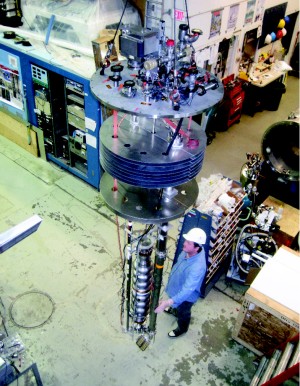
Cornell’s first ERL cavity during its vertical test showing the required small energy loss. Image: Cornell / LEPP
Almost invariably, when superconducting accelerator cavities undergo performance tests, they present a dual personality that leaves researchers scratching their heads. When the niobium structure is stood upright (on a test stand), its quality factor mimics its posture – it measures high. But when the same cavity is placed horizontally in a cryomodule, its quality factor falls – often cut in half.
Scientists aren’t sure why this happens, but to achieve the large quality factors needed for continuous-wave accelerators at Cornell University’s ERL project, the effect has to be understood and eliminated. They may have eliminated one culprit in a recent horizontal cavity test.
Late last year Cornell’s SRF group, headed by Georg Hoffstaetter, obtained a quality factor that prevailed against the usual drop. They found that their cavity prototype, once placed in the horizontal cryomodule, achieved a quality factor of 2.8 x 1010, exceeding its vertical test stand value. The measurement was taken with hooked-up instrumentation, but without the input coupler and the higher-order mode absorber in place.
The quality factor, or Q, indicates how much energy is stored in the cavity versus how much is dissipated in one oscillation of the electromagnetic field. Higher Qs indicate less energy loss in the cavity wall and are therefore better for accelerating particles.
One hypothesis for the oft-experienced drop in Q says that dirt and other impurities settle in the cavity cells’ equator regions, where there are large magnetic fields, when the cavity is laid flat. This dust could absorb energy, bringing down the Q. Cornell’s cavity had consequently been assembled with great care for cleanliness.
The test is part of a research programme to pinpoint the cause of decreases in Q whenever a superconducting cavity is placed in a cryomodule. Cornell researchers will continue the programme for the next year, taking measurements of the 1.3-gigahertz cavity’s Q at various points on its way to being fully equipped for an SRF linac.
“We want to see at what step of linac construction the Q factor gets worse, or figure out whether we can make the construction so clean that we can keep the Q above 2 x 1010,” Hoffstaetter said. “In the first stage of our test, we found that our cavity still had what we needed.”
The result was one of a trio of milestones the Cornell team recently achieved for their energy recovery linac (ERL) research, an ongoing programme to build a low-energy-consumption, high-brightness, high-current ERL at the university.
The motivation behind the Cornell ERL is to produce exceptionally useful photon beams that would be applied in medicine, materials and industry.
Producing a low-energy-loss, and therefore less expensive, superconducting radiofrequency cavity is one major part of the ERL programme. Another involves producing a tight electron beam.
The dominant problem with making electron beams tight is that the particles repel each other because of their like charge. Overcoming this space charge problem to get a low-emittance (small-width) beam involves tricky magnet arrangements to focus the beam equally along the length of each particle bunch.
The goal for Cornell’s beam injector is to produce a 100-milliamp current with a 1.3-GHz bunch repetition rate. At a corresponding charge of roughly 80 picocoulombs per bunch, the strong space charge forces make it difficult to produce the necessary small emittances. Yet Cornell scientists skillfully honed a method for compensating for overly zealous particles in the bunch, bringing them into line.
In their second milestone, they achieved an emittance of 0.3 millimetre·milliradians at the full bunch charge of 80 pC for the core of the beam (or 75 percent of the particles). Their goal is to bring not only the core, but the entire beam down to the 0.3 mm·mrad value, improving the optics so that they can fold in all of the particles at the beam’s fringes.
The bunch repetition rate – and therefore the current – was reduced for this second milestone to preserve the emittance-measurement equipment. But Cornell researchers operated at the nominal 1.3-GHz rate in a third project to push at the high-current frontier.
Achieving yet a third milestone, they also generated a world-record current for any laser-driven photocathode electron gun. Their prototype injector reached a current of 50 milliamps – halfway to their 100-mA goal. To reach their goal, researchers still need to overcome a few challenges.
One is to figure out how to supply the high amounts of power needed to get the desired current without overpowering the couplers. They also have to keep the electron beam narrow and stable, which requires exquisite magnet alignment. A small beam halo and a narrow electron beam require that the laser beam hitting the photo-emitting cathode of the electron gun is also well focused and stable.
Their work seems to have paid huge dividends recently. At first efforts to boost the current progressed slowly, taking about two years to get to 10 mA and then a little more than a year more to double that value. Then, after putting more effort into properly aligning and stabilising the laser, magnets and other components, the current shot up to 50 mA in only six months. They’re now confident they’ll reach the 100-mA finish line.
Adding to the upbeat sense of accomplishment in scoring the ERL milestones was their unexpected, practically simultaneous arrival. The Cornell group reached all three in a brief two-month span.
“The time was ripe to reap the successes,” Hoffstaetter said.

Recent Comments